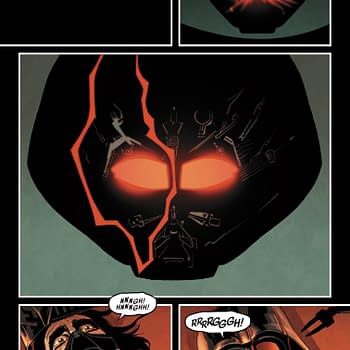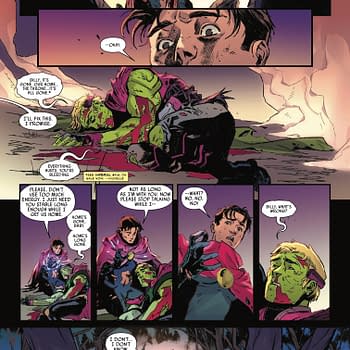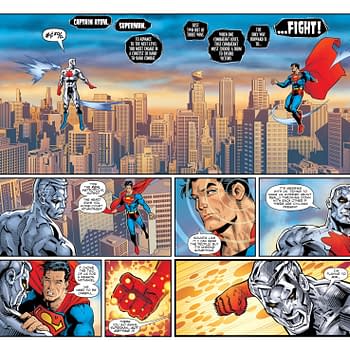Posted in: Comics, Recent Updates | Tagged: avatar press, Boom! Entertainment, Comics, dc comics, entertainment, Futures End Week 1, god hates astronauts, God is Dead: Book of Acts "Alpha", image comics, Lumberjanes, original sin, The Death-Defying Doctor Mirage, The Woods Vol. 1, valiant entertainment
Thor's Comic Review Column – God Hates Astronauts, Original Sin, Futures End Week 1, The Death-Defying Doctor Mirage, God Is Dead: Book Of Acts Alpha, Lumberjanes, The Woods Vol. 1
This Week's Reviews:
God Hates Astronauts #1
Original Sin #8
Futures End Week 1
The Death Defying Doctor Mirage #1
God is Dead: Book of Acts Alpha
Lumberjanes #5
The Woods TPB Vol. 1
God Hates Astronauts #1 (Image, $3.50)
By Bart Bishop
Originally a web comic collected in trade by Image, God Hates Astronauts may be the craziest comic I've read, like, ever. In the span of the first issue of the new ongoing series, writer/artist Ryan Browne manages to cram in spaceships, crab-headed aliens, tigers eating cheeseburgers, the most condensed superhero team origin put to paper, a 3D meta-being breaking the fourth wall, astro-farmers, and a chicken that gets transferred into a human body. Somehow, in all of this, there's a hint of logic and consistency.
Browne, who I'm familiar with from his work on The Manhattan Projects, has a supreme degree of irreverence and lunacy that still abides by a set of rules within a functioning world. He's also laugh-out-loud funny, managing to make me guffaw in ways a comic book hasn't made me guffaw since the likes of Garth Ennis's Preacher and Punisher. Browne knows how to push a punchline to its breaking point, in a prose and visual sense, and often finds synergy with both, making for a fantastic first issue.
The premise is… hard to put into words. The Power Persons Five are a superhero team, with a leader that has a flaming blue cow's head, commissioned by NASA to prevent any amateur astronauts from trekking out into space. This is to keep the peace with King Tiger Eating a Cheeseburger, who has commanded Sir Hippothesis (yes, he's a hippo) that space is off limits for humans. In this case, specifically Lord Astro-Farmer and his cult-like followers want to make it to the "golden moon-heaven" where sexual relations between man and chicken are not frowned upon. The peace is broken, however, when King Tiger Eating a Cheeseburger's son Admiral Tiger Eating a Cheeseburger is killed in a SPACE COLLISION! with some wayward farmers. If that sounds bizarre and possibly hard to swallow in concept, the execution will leave your mind melted.
So what mad brain spawned this monstrosity? Ryan Browne approaches the written word with a sledgehammer, avoiding any lick of subtlety. Crab-headed aliens from the Crab Nebula worship Crab Jesus. Tigers Eating a Cheeseburger indeed eat cheeseburgers, apparently constantly. The raunch and the brusque collide with strange, strange moments of poignancy. Many an F-Bomb is dropped, but somehow always perfectly timed for maximum spit-take effect.
The real standout is 3-D Cowboy, who takes a timeout in the middle of the issue, well beyond the point of no return for readers to be utterly overwhelmed, to explain The Power Persons Five's back story. Speaking directly to the reader, it's hard not to hear a high-pitched helium voice along the lines of Mr. Bill chirping this bit of exposition. It's hard to really get comfortable, however, as the point of view switches from Mr. Crabtree to Lord Astro-Farmer to The Power Persons Five to King Tiger Eating a Cheeseburger, with the majority of them being less than sympathetic or relatable. I don't need to like a character to find them engaging, but even in parody there needs to be something to ground a character in a narrative even if its competency. Perhaps that's why The Impossible, however brief in her superheroics, grabbed my attention as she appears unflappable and looks cool at the same time.
The art is appropriately complementary to the writing. Browne has a feathery style reminiscent of Joe Kubert's sketchy, rounded figures but with the kineticism and immediacy of Jack Kirby. Star Grass's chair, for instance, is very reminiscent of Metron from the New Gods, but more so than that it's the bombast of how the characters burst forward as if they're going to escape the page. It's the unexpected combinations, as well, such as chicken-headed women and hippos wearing kingly attire that make for great visual gags, along with the sound effects that point out the obvious or serve as succinct exposition.
If that's not enough, Browne breaks down the wall between creator and reader with a credits page praising anyone that bought the book with a degree of hucksterism that would put Stan Lee to shame, a "title sequence" with the aesthetic of an Old West wanted poster that prompts one to "press start with your mind-finger to continue" combining the past with the future, and a closing page anticipating critical outrage for and against the book. The sauciness on display is clever and knowing along the lines of Douglas Adams, but if Adams was a five-year-old hopped up on Red Bulls.
The best part about this book is I have no idea where it's going next but it doesn't matter because the amount of imagination on display is sure to be entertaining.
Editor and teacher by day, comic book enthusiast by night, Bart has a background in journalism and is not afraid to use it. His first loves were movies and comic books, and although he grew up a Marvel Zombie he's been known to read another company or two. Married and with a kid on the way, he sure hopes this whole writing thing makes him independently wealthy someday. Bart can be reached at bishop@mcwoodpub.com.
Original Sin #8 (Marvel, $3.99)
By Jeb D.
In concept, the Original Sin miniseries held some promise. It was a dark murder mystery written by a guy, Jason Aaron, who does dark like few others in today's corporate comic environment. It was billed as (and pretty much was) the most self-contained Marvel "epic" in some time: you could skip every potential tie-in without missing a single story beat. And it was going to unlock some "secrets" that would open up new storytelling possibilities for our favorite characters, deferring the latest rematch with Kang or the Red Skull, in favor of exploring some different paths, establishing new relationships and/or status quos. Aaron even dabbled in some large-scale "Man vs God" philosophizing on the subject of free will. All of that would matter more if it had actually been anywhere near as strong as his best work.
While I have a limited amount of sympathy for anyone who is actually able to make a living writing comics, what I do have goes out to Aaron here: almost before his book was launched, the realities of marketing comics in the online age overtook it. Long before we reached the denouement of Original Sin, we already knew that the Marvel Universe would be getting a black Captain America and a female Thor; that it would take a time-jump forward; that Wolverine would die; that there would be an inversion of heroes and villains… and on top of all of those, that next January's going to bring us another upheaval in the Marvel U that will evidently render everything that came before inconsequential, if not irrelevant. The answer to "Who Killed the Watcher?" was basically yesterday's news when yesterday was still tomorrow.
None of that really excuses the sloppiness of the storytelling in Original Sin, or its tedious pacing, but it might reflect necessary compromises in shaping the story from initial pitch to final result. As an example, in any superhero epic, part of the fun comes from interesting and unusual juxtapositions of characters, but the ones in Original Sin seem random enough to have been assembled by means of a dartboard or roulette wheel, including Gamora with Bucky and Moon Knight or the "where the hell did you come from?" association of Black Panther, Ant-Man and Emma Frost (Frank Castle and Dr. Strange fare a bit better, as they compare the particular forensic techniques involved in the investigation of murders on an astral plane).
Then, after a bit of banter in the early issues, these team-ups don't much go anywhere (the only actual piece of plot development is something Bucky does on his own). Really, once we approach the climax, Captain America's the only character apart from Fury who's given much to do (and he's really just running variations on his usual leadership harangues). At least Cap agrees with me that the whole "Illuminati" concept was one of the less-appealing retcons in Marvel history, and if Axis winds up giving them the bum's rush, I won't be sorry.
And speaking of retcons, the idea that Nick Fury spent decades as some kind of Green Lantern-style cosmic watchman for humanity during his free time is the kind of thing that might have some resonance, given proper buildup and context, but in this series, it's simply a story that Nick might just as well have made up on the spot. In fact, you could actually remove it from Original Sin without significantly affecting the outcome: we already know that Fury has spent his entire career fighting evil in various forms, and the fact that he occasionally did it in a Wally Wood spacesuit while we weren't looking doesn't shed much light on anything.
The "murder mystery" itself isn't particularly well plotted out, as Aaron's suspects consist of one set of villainous characters whose motivations are so obvious as to clearly be red herrings, and Fury himself. Up to the final reveal, I suppose it would be possible to argue that any number of other characters in the Marvel Universe could have done it, but it would have been a cheat wholly outside the context of the series. The story serves its purpose in clearing the decks for the current Nick Fury, but I'd have thought that the old man simply having gone into hiding off the grid was working out just fine.
I did like the fact that Aaron seems to be riffing slightly on Preacher, as Fury, after a lifetime of struggling against dark forces, seeks to bring The Watcher to account: Uatu has access to all that Fury would need to do his job, but refuses to get involved—well, at least, that's Fury's interpretation; the canon is more or less that The Watcher isn't allowed to do anything but watch, though Fury seems to be about the only person in the history of the Marvel Universe for whom Uatu will actually apply the rule. But it's not really explored, beyond Fury's incessant, repetitive snarls and curses, and the consequences are crammed into the last pages of this issue; by the time Uatu goads Fury into killing him because he's "seen too much", it's a resolution that technically satisfies the demands of the plot, but has no resonance for us. Equally arbitrary is the decision to give us a weepy panel or two of The Watcher's wife, as if to insist that we feel something for the latest in the unending line of Marvel character deaths.
Original Sin, as a series, is not completely dismissible, though, as it features maybe the best work I've seen yet from artist Mike Deodato. The typical Marvel "cosmic" adventure owes a lot to the bright energy of Jack Kirby, full of the promise of the young "Space Age"; Deodato, though, is going for something more reminiscent of Gene Colan's handling of Doctor Strange: dark worlds beyond our ken that are not simply unknown, but unknowable (colorist Frank Martin lays an appropriately interstellar haze over the book). Actually, Deodato's paneling also reminds me of the sharp diagonals that Colan brought to characters like Strange and Iron Man, as well. Most of all, he validates Aaron's use of a rather dull set of supervillains by doubling down on the creepiness of The Orb, though he can't do much with the generic qualities of Doctor Midas and Exterminatrix. Given that the story involves eyes being removed, decapitations, and the like, Deodato and Martin are appropriately gleeful in their pursuit of gore. I could do with a bit less of the Photoshop blur, but this really is a beautifully illustrated comic.
By the time the trade collection hits the shelves, Original Sin will already be half-forgotten in the ongoing rush of Marvel event books; but at a relatively compact eight issues, it should make for a nice, chunky volume (unless Marvel goes for the added margin by releasing it in two parts) for Fury completists or Deodato fans. Jason Aaron fans, though, can just stick with Thor—I hear he's due for an upgrade.
Jeb D. is a boring old married guy whose comics background includes attending the very first San Diego Comic-Con, being lectured on Doc Savage by Jim Steranko, and fetching an ashtray for Jack Kirby. After a quarter-century in the music biz, he pursues more sedate activities these days, and will certainly have a blog or Facebook account or some such thing one day.
Futures End Month, Week 1 (DC Comics, $2.99/$3.99)
Earth 2: Futures End #1
Grayson: Futures End #1
Green Arrow: Futures End #1
By Graig Kent
Last week in this column I reviewed The New 52: Futures End weekly series to date, noting that this week marks DC's annual month-o'-lenticular-covered one-shots, this time with the theme of Futures End taking over most of the DCU's regular titles. I won't go into the history lesson on this, save to say this sort of series interruptus has been an ongoing thing at the Big Two since Crisis on Infinite Earths, although this particular sub-event has its roots more firmly tied with time-hopping "what if" events like Armageddon 2001 and DC One Million.
It's a mixed bag, this annual New 52 collector's bait that DC puts out. It's been a profitable endeavor for the company each year so far, and it indeed stirs a lot of collector interest, but at the same time it throws the retailer's ordering schema for a loop and can alienate the casual reader as much as it entices the entrenched. I know that in past years, with "Zero Month" and "Forever Evil", I picked up only the titles written and drawn by the regular creative team of the books I read, which usually meant I was picking up less than half of my monthly DC pull.
Since I'm actually quite enjoying Futures End, for this month, I will be looking at books I expect to be key one-shots that tie into the weekly series, as well as the Futures End issues that tie to the DC titles I read on the regular.
I'm not entirely certain what I was expecting from these Futures End one-shots. In my mind I was thinking that each should sort of bridge the gap between the present day and the "5 years from now" setting of the weekly title, but that would be rather tedious reading if every book followed that plan. I had hopes that Earth 2: Futures End would explore the "Earth War" that forms much of the backdrop of the 5-years-later society, particularly what happened on Earth 2 to instigate their crossing over into Earth One and what sparked the war itself. It's touched upon plenty in Futures End, as most of the heroes are dealing with loss, guilt, or PTSD, but what actually happened or why isn't entirely clear (I'm not a regular reader of Earth 2, so it's possible that events are already somewhat set up there).
Earth 2: Futures End, instead, deals with Michael Holt/Mister Terrific squaring off against his nemesis, Terry Sloan, first as business competitors showing off their wares to the military, then as combatants of muscle and mind as they fight over control of Holt's latest project, one that can imbue the user with God-like powers. There are side steps dealing with Earth 2 Lois Lane/Red Tornado and Earth 2's Jimmy Olsen, and notes about how the Earth 2 refugees are considered second-class citizens on Earth 1, touching on the racism directed towards them, but for the most part this is a highly compressed (too much so, in fact) story that feels too disconnected from Michael Holt as we see him in the Futures End weekly.
The story from Daniel H. Wilson moves at an exhausting pace, attempting to deliver a movie-length story in only 20 pages (including an interlude where Holt is on the run from the law). His Michael Holt has none of the swagger of the Holt we see in the weekly, and his usual aides and digital confidant that seem ever-present in the main Futures End series are completely absent. It appears Eddie Barrows (with inks by Eber Ferreira) didn't get the model sheet for Holt (nor any reference copies), and the world's smartest man (and one of the most successful) decked out in a plaid flannel shirt tucked into his jeans seems an ill-fit for this character, especially as we've seen him elsewhere. Skip this one.
Were I not already picking up the highly enjoyable Grayson series, I would have given this book an outright pass, since the character has no presence in Futures End, plus his world of espionage is only 2-issues deep, so how much material can possibly be mined for a "5 years later" story?
Turns out quite a bit. Series co-plotter Tom King handles full writing chores here and crafts an ambitious and brilliant little tale that spans a good chunk of Dick Grayson's life, all told in reverse order. Starting with Dick hanging from the end of a rope by his neck, the story steps back one page at a time to show Dick murdering the Russian President (KGBeast) at a ceremony intending to honor him. The story keeps stepping back in time, page after page, each step taking a much longer stride, illuminating what's happened before… erm… after?
There are wonderful levels to King's story, bits that don't make sense at first until you've finished the story and give it another pass ("the Cluemaster's Code", "the rope trick"). Rich Johnston likened it to Memento and there's a bit of that feel to it, a puzzle to solve, but it's not quite as complicated as the Nolan film. This isn't the first time this structure has been used in comics, either, so it's not that King's story structure is innovative (see Brian K. Vaughan's story in Midnighter #7 from 2007) but it's used to delicious and highly entertaining effect.
With only a couple issues under the series belt, King builds his story around Dick Grayson, his relationship with his partner-in-spy Helena Bertinelli, his history as former boy wonder, and the trauma that led him there. In the process, King posits a most reasoned answer to the question of why the Robin costume is so brightly coloured ("Earn the night," Bruce tells him), and shows the beautiful human side of this character as he comforts a young child in the aftermath of war. There's even some sexy-time for old Dick, as is this title's mandate (although it's unfortunate that artist Stephen Mooney doesn't seem so comfortable with the beefcake as series artist, Mikel Janin, but he otherwise services the story well). It may not have much in the way of ties to the ongoing Futures End, this is a fantastic read regardless. This is definitely my favourite done-in-one story so far this year. Even if you're not into Futures End at all, it's worth picking up.
With the death of Green Arrow a key moment in the first few issues of Futures End, and Oliver Queen's little sister Emiko playing a key supporting role in the series, not to mention that outgoing Green Arrow writer Jeff Lemire is one of the four architects of Futures End, I had high expectations that Green Arrow: Futures End would be highly integrated with the weekly series. Not only is it just that, but it also provides a nice payoff to Lemire and artist Andrea Sorrentino's run on Green Arrow. On the first page alone we find that Emiko has assumed the mantle of Green Arrow and Oliver's long-time ally Naomi Singh has taken on a vigilante guise of her own as Dart. Shado, Magus, and the Outsiders put in another appearance, providing some closure to their stories, and unlike even the main Futures End itself, where its "5 years later" setting feels arbitrary and hypothetical, the story at hand here feels like a genuine continuation of Lemire and Sorrentino's great run.
At the same time, it completely dovetails into the ongoing story of Futures End, with much of the book leading up to the death of Green Arrow (which happened off panel before), and shedding more light on the reveal that happened in issue 18 of the main series this week. It's a wonderful feather in the cap for Lemire and Sorrentino's run (which I wrote about a few weeks back). This one's well-integrated with the weekly series – not an essential accompaniment, but worth the pick-up. It's a must-read for the Green Arrow readers though.
Next Week: Batman, Constantine, Justice League United, Suicide Squad and World's Finest.
Graig Kent needs to sort his comics. He would like steak and potatoes for dinner. He should buy that new New Pornographers album. He should remember to pay his bills on time. He's been staying up late watching tennis. He can be found on twitter sometimes @thee_geekent , his dog has a blog tacomblur.tumblr.com. and he just reviewed The Raid 2 at wedisagree.blogspot.com.
The Death Defying Dr. Mirage #1 (Valiant, $3.99)
By D.S. Randlett (@dsrandlett)
Grief and loss have been a part of heroic literature since at least The Odyssey, the story of a prideful yet shell-shocked veteran making his way home, and part of the oral tradition since well before that in stories like that of Heracles. Loss seems to be the universal motivator, as it performs the trick of making home no longer feel like a safe place, or upending what was once familiar. What better way to spur on a journey? The new Dr. Mirage series differs a bit from your standard heroic tale in that grief and the accompanying death aren't there simply to present an impetus for a journey, but they are a constant presence in the story, affecting the actions of the characters and the texture of the work itself.
I'm not that familiar with the original iteration of Dr. Mirage. I just remember that it debuted not too long before the publisher was to be acquired by Acclaim Entertainment, which would go on to run the company into the ground in just about every respect. I do remember the original Dr. Mirage being a man, Hwen Mirage, who had "died" and existed as an incorporeal being who endeavored to restore both his marriage and physical existence. Jen Van Meter and Roberto De La Torre's intelligent reboot, featuring some amazing colors by David Baron changes a lot about the concept, but keeps its core ideas of disconnection and the paranormal at its center.
A lot of the changes are for the better, and the title's slow burn and current disconnection from the larger Valiant universe give the current Dr. Mirage a more grounded feel than its forerunner, which was more of a straight up superhero book. Van Meter's script starts in medias res, but lingers on some smaller moments before getting to the main hook of the series' first adventure, and even that hook has sort of a slow-burn quality to it. This issue does not feature the origin story of Dr. Shan Mirage as much as it does let her world, and her character, unfold.
The book opens with a reluctant Shan meeting with a group of widows. It ends up being a touching scene, where Shan is able to speak with the lingering spirits of these widows' dead husbands and tell them that one last thing. Much about the scene speaks a lot about where this character is at in her life. While Shan can speak to the dead, she has yet to see the spirit of her departed husband, Hwen. As a result, Shan is a bit of a loner. After all, in a world where she can speak to the dead but not her own departed beloved, she has a greater claim on grief than anyone else. And that's not even getting to the extremely compelling hook, about which the less is said, the better.
Van Meter's script lets itself out more like a mystery novel than a superhero book, slowly setting up plot pieces and characters instead of pressing the detonator and letting origins and characters explode into action. But by the end, Dr. Mirage proves itself to be very much of the superhero lineage when Shan is given the chance to set things right at great risk to herself. I don't want to spoil anything, but she takes the risk, and in doing so sets up a clever inversion of the original Dr. Mirage dynamic.
The art by Roberto De La Torre and Dave Baron is extremely fitting for a different kind of superhero book. De La Torre's layouts really bring the pacing to life. Not in the sense of speeding it up, but making the emotional charge of the writing more tangible. Instead of a punchy superheroic rhythm, De La Torre gives us something like if Sergio Leone worked in the genre, full of large panels that linger on his subjects and their moments while working with a very rigid system of grid layouts. It has the effect of a very slowly ticking watch, or tentative footsteps down a dark hallway, which is absolutely perfect. De La Torre's sketchy pencils are also just plain gorgeous.
David Baron's colors deserve special mention here. On the most basic surface levels, Baron's work is simply astounding, complimenting De La Torre's Leone-esque long takes with Leone-esque washed out colors. This should come as no surprise, as the man's been one of the best in the business for years. But on Dr. Mirage specifically he gets the colors themselves to tell a story. The book starts in a pretty mundane place, and by the end we're in a place that's much less mundane, and Baron makes the colors tell that story, with the pallet seeming to change ever so subtly as the issue proceeds towards its conclusion.
I've been impressed with the Valiant First books so far, and Dr. Mirage is no exception. While the story doesn't exactly blow the doors off in terms of thrills or urgency, it is told with a level of craft and honesty that is rare in any medium, and that can only foretell good things.
D.S. Randlett lives in the hills of Virginia and takes credit for the reviews that his emaciated twin brother writes while chained to the old radiator. He plays his guitar while biding his time for unsuspecting tourists and thinking about going to grad school.
Better Late Than Never: God is Dead Book of Acts Alpha (Avatar Press, $5.99)
By Adam X. Smith
I always felt bad I never gave Jonathan Hickman and Mike Costa's God is Dead a look sooner – our own Jeb gave it a review a while ago and I always felt like I'd missed a trick. So when found out about its spin-off Book of Acts and that it would include contributors from fellow Avatar Press writers Alan Moore and Simon Spurrier, I knew I was going to have to take a look at some point.
In Costa and Rafael Ortiz' opening segment "Arts & Letters", Ifrit is brought into existence and expected by Ganesha to investigate the death of Kamadhenu, the Great Cow of Plenty. He tells the elephant god where he can stick it, pledges allegiance to Iblis, and goes off to live a debauched existence, all the while struggling to ignore the nagging need to fulfil his purpose. From Spurrier and Gabriel Andrade, there's the especially good "Pitter Patter" which deals with the impact of changing perceptions regarding the nature of religion on different theological beings – by presenting a resentful, chain-smoking, hard drinking cherub telling the story of his futile attempts to be taken seriously by humanity.
And in the middle, we get a piece of "Grandeur & Monstrosity" from Moore and Facundo Percio, in which, in the wake of entire pantheons of gods returning, Moore finds himself put in the unenviable position of having to explain Glycon to everyone in the world, by virtue of the fact that he is, in his words, its only worshipper in eighteen hundred years. Puppetry is involved.
Based on that description, I'd understand if people unfamiliar with the series would probably be a little uncertain about jumping into this – being an off-shoot of the series, it doesn't exactly prep you for what to expect from the book itself. But what it does do is show that the concept of a universe in which the gods of every pantheon not only exist but walk among us has a lot of room to play in.
There's only so much I can say about this without spoiling it for anyone – if you've not already read it, you could definitely do a lot worse than to dig it out. If you're an Alan Moore fan, buy it for his contribution (especially if, like me, you're eager to check out his new film project Show Pieces which seems to have some connective tissue in common with it). Even if you're not a Moore fan, it's worth it for Spurrier's contribution – you'll never look at Cupid the same way again.
Adam X. Smith is a paranoid android from the Planet X. For the last 27 years he has been living amongst the people of Birmingham, England (and more recently the University of Lincoln) ostensibly as a student of the school of hard knocks (also BA Hons Drama), but secretly on a mission to scout out the planet for invasion by alien forces; his weekly communiques on his various blogs are actually highly coded messages to his extra-terrestrial masters. He enjoys the musical stylings of local chiptune-metal band Elmo Sexwhistle, the fiction of Kim Newman, Kurt Vonnegut and Chuck Palahniuk, and his hobbies and interests include film-making, drama, occasional Youtubing, journalism and plotting the subjugation of humanity. He can be found on Youtube, Tumblr, Twitter or by jamming an ice-pick through the optic chiasm.
Lumberjanes #5 (Boom! Box, $3.99)
By Joe Colewood
It's coming up on two decades now since the comics industry collapsed in spectacular fashion following the short-sighted speculator's boom of the late 80s and early 90s. One of the consequences of that industry-wide economic meltdown is that when all the people who had been hoping to get rich from collecting comics realized that they'd been had and bailed out, the people who were left buying (and writing and drawing) comics were the ones who really loved the medium for what it was.
The comics industry is still, in many ways, reeling from that downturn, to the point where it's become axiomatic that comics are in desperate need of increasing their audience. And since the aging male nerd audience is, famously, pretty well represented, most comics types accept that there's vast untapped potential among 1. children, 2. women, and 3. child-women, or "girls" as they're commonly known. (Sorry, I'm a comics reader, this is all strange untapped territory for me.) Unfortunately, the very economic desperation that made it so necessary to diversify the audience is the same thing that keeps most publishers clinging desperately to what they know, and for a long time the ones who did try to tap one of these untapped markets often had no idea how to reach them, often resulting in failure, and thus, a self-reinforcing fear of trying again.
Something seems to have broken the cycle lately, though — probably the fact that the comics industry is on slightly firmer ground these days, financially. Thanks, Hollywood! The result is that these days, the existence of a book like Lumberjanes, aimed squarely at young girls, isn't really newsworthy, which explains why I just spent two paragraphs talking about how newsworthy it isn't.
The premise is simplicity itself: a troop of pseudo-girl scouts, at camp for the summer, keep stumbling onto insane supernatural goings-on in the woods. Initially it was only the five members of Roanoke house (tiny-but-apparently-superstrong April, punky Mal, blonde archery expert Molly, hyperactive Ripley and perfectionist leader Jo) but in this issue the entire camp is swept up in a dinosaur attack. And also everyone makes friendship bracelets. You can too! Instructions included!
The page devoted to arts 'n' crafts sort of typifies this book, in that there's a legitimate, dorky, "interactive" feel to it that you get with real girl (and boy) scout material. Previous issues had the 'Janes identifying wild plant life and solving anagrams. It all stops just short of being (shudder) educational, which as everyone knows is the last way to attract actual kids. Fortunately (?) if that's writers Noelle Stevenson and Grace Ellis's intention, they know enough to sneak it in and foreground the crazy supernatural shenanigans. Oh, and to make it a hilarious book, which it is (favourite bit: the counselor screaming "EVERYBODY RUN" as a velociraptor leaps at them; everyone else replying "YES WE KNOW" as they scatter in a panic). Artist Brooke Allen has a style, and an energy, highly reminiscent of Kate Beaton, and yes I do mean that to be high praise.
Lumberjanes is, as I said, a pretty dorky book, and that's exactly why I love it so. Let's not forget that the comics industry has been supported for most of its existence by dorky books–I'm not even talking about the relative nerdiness of superheroes, I'm talking about the stuff that the superhero fans tended to ignore, your Archies, your Little Dots, your Bob Hope meets Frankensteins*. They provided the fertile soil for kids who could then mature into serious, sophisticated readers of comics where Batman poops himself. Of course, the tables have turned now, and the dorky books are the minority–which gives them a certain underdog flair. I'd argue comics themselves came back from the aforementioned economic crash stronger than ever, at least for a short time, because the only people left were, as I say, the ones who really loved the medium. And this holds true for comics aimed at young girls nowadays–it's a niche market, so the people who make them have to be passionate about what they do. Fortunately, if more books like Lumberjanes come along, maybe it won't be such a niche market anymore after all.
*This may not exist. But it says something about old comics that I'm honestly not sure it doesn't.
Joe Colewood is a great man, a man of vision. No one understands him. He had good reasons for doing the things he did. Consider the 20 years of peace in Lichtenstein, not to mention the electric toothbrush, and ask whether it was all worth it. The whereabouts of the bus full of nuns was never ascertained, anyway. You'll see. History will vindicate him.
Woods TPB Vol. 1 (Boom!, $9.99)
By Cat Taylor
Every once in a while, a comic book comes along that reminds me that I'm way too old to be reading comic books. The first volume of the Woods is one of those books. It's not that I found the story or subject matter to be beneath me or childish but rather the general portrayals of children and adults seemed false. As with many movies, books, etc. aimed at a teen or "tween" audience, the kids in the Woods are the protagonists and are far more emotionally together, mature, and smarter than the adults in the story.
The portrayal of the mental maturity of the main teens in this story is far beyond what I've ever experienced from adults in real life, much less teenagers. So, the challenge for me to constantly suspend my disbelief that there wouldn't be a lot more freaking out at the circumstances, a complete loss on how to handle things, and a hopeful though pessimistic reliance on the adults, was a hard pill for me to swallow.
In contrast, the teachers and other faculty members in this story are shown as incompetent or outright evil. The portrayals remind me a lot of characters from stories that my friends and I wrote when we were teenagers, which were basically adolescent fantasies that demonstrated how much smarter we were than adults realized and how much dumber the adults were than they thought. Like I said above, I am definitely not the target market for this story.
Even so, it would have been nice to see a little more dimension to the characters that exceeded broad stereotypes. The creators seem to go out of their way to show a multi-racial group of kids who mix together without any segregation but that doesn't overcome the generic portrayals of the kids as nothing more than ultra-mature versions of high school archetypes seen in movies like the Breakfast Club.
It's disappointing that the characters aren't better written though because the general plot and execution of the story otherwise is pretty enjoyable. The story begins with the entire high school suddenly and inexplicably transported to the middle of a forest on what is apparently another world. Aside from the obvious challenge of trying to figure out what happened, how to get along and survive, and how to return home, the characters encounter all manner of strange and dangerous creatures that are unlike anything they've ever experienced and there is additional danger from certain faculty members and fellow students who have taken a somewhat Lord of the Flies route in light of the new circumstances.
The writer, James Tynion IV, who is probably best known for his work on Batman Eternal, has put the characters in an alien world where the reader is learning about the world at the same pace as the characters, and there are plenty of surprises and mysteries to hold our attention. Tynion seemingly wants to make the point that he means business early in the story by brutally killing one of the characters. Not that it's unusual to have early deaths in a story like this but it was the choice of characters that was a surprise. The violent death of this character violated a sort of unspoken taboo for teen fantasy stories and is also an apparent attempt to let the reader know that nobody is safe.
Much credit also has to be given to the artist on this issue as well. Michael Dialynas doesn't use the style of art you might expect but his work unquestionably jumps out at you. Dialynas uses a strong pop-art style that would sit comfortably alongside American television cartoons or anime. The characters have a simplistic, almost comical quality but the big scenery like the woods themselves, monsters, etc. are highly detailed where it matters, really giving us a lot to look at. This is also a book where the colorist has a big impact. Josan Gonzalez uses bright pop art colors in general, but in the outdoor scenes Gonzalez uses some unusual hues of those colors that reflect the pink/purplish alien light cast down on the world below.
While this is only the first volume of what will ultimately be a lengthier series, the pacing so far has been nearly perfect. There is a lot going on in this first volume but the surface hasn't even been scratched regarding the main mystery of whatever is going on here. If I were a teenager and could buy into the characters a bit more I would surely be hooked for the next volume. As is, I am still interested and want to see where this is going but I don't have that strong connection with the material that is typically essential for creating an enthusiastic and dedicated fan.
Cat Taylor has been reading comics since the 1970s. Some of his favorite writers are Alan Moore, Neil Gaiman, Peter Bagge, and Kurt Busiek. Prior to writing about comics, Taylor performed in punk rock bands and on the outlaw professional wrestling circuit. During that time he also wrote for music and pro wrestling fanzines. In addition to writing about comics, Taylor tries to be funny by writing fast food fish sandwich reviews for Brophisticate.com. You can e-mail him at cizattaylor@hotmail.com. He needs to wrap up this review because he's performing as Johnny Rotten in a Sex Pistols tribute show tonight you bloody wankers!

























